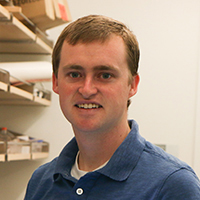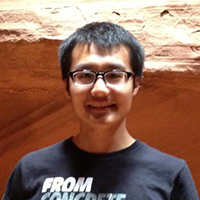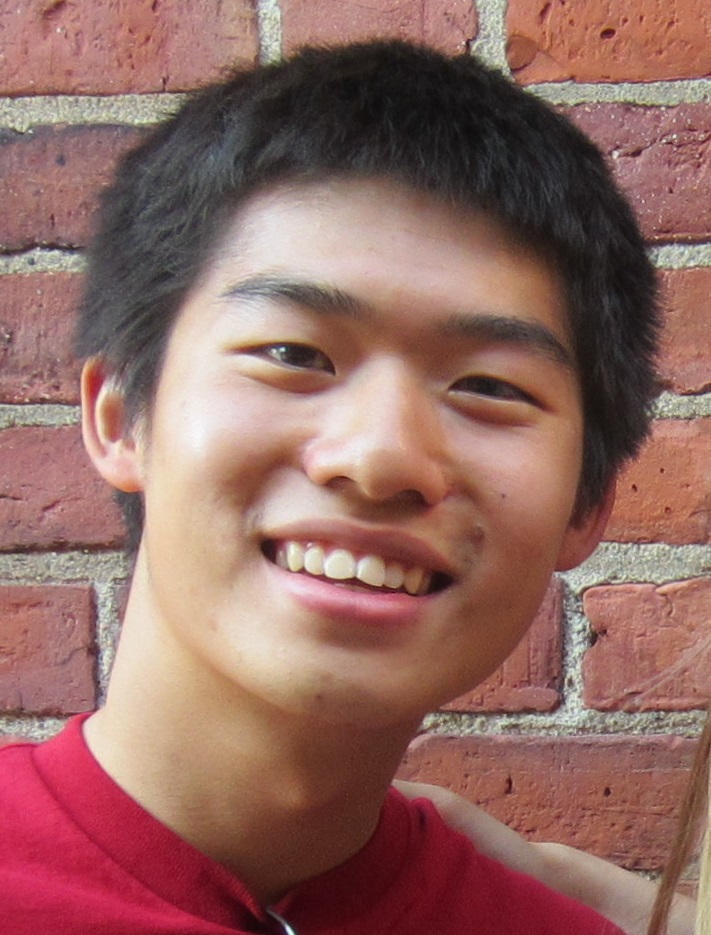In addition, I am working on the project of utilizing Raman spectroscopy for the inspection of sperm quality. As a non-invasive inspection approach, Raman spectroscopy provides detailed information on the internal structure of molecules without the need of labeling. This research will contribute for the selection of high quality sperm in andrology research.


Greg Liddiard
I received both my B.S. and M.S. degrees from the University of Utah in Electrical Engineering and am currently pursuing a Ph.D. in Electrical Engineering. I’m working to develop easily integrated microvalves, pressure regulators, and pressure amplifiers for use in microfluidic lab-on- a-chip systems. I’m also working on medical garments for prevention of pressure ulcers in immobilized patients. Outside of the university I work with a local medical device company developing MEMS based pressure sensors with a specific focus on packaging for ultra-low pressure and harsh environment applications.
Integrated Microfluidic Control Devices
Microfluidic lab–on-a- chip systems offer a number of very enticing advantages over their macro counterparts. One glaring disadvantage, however, is that often a number of “off chip” support devices must be used in order for the microfluidic chip to properly function. This limits both usability andportability. My control devices research focuses on fluidic flow control mechanisms that can be easily incorporated into a device using processes already implemented to create the necessary channels and chambers. The goal is to provide an electrically controlled, completely integrated solution, with only a single off-chip pneumatic source. This will be accomplished using a combination of custom designed polymer based electrostatic microvalves, pressure amplifiers, and pressure regulators.
Pressure Ulcer Prevention Garments
Patients experiencing prolonged hospitalization, or with spinal cord injury, often suffer from pressure ulcers or sores that can delay their recovery and can result in extended hospital stays thus adversely affecting overall health and increasing healthcare costs. Generally, hospitals transfer patients to pressure relieving beds only after the appearance of sores, due to the high costs of such beds. My active geometry garment research seeks to provide a cost effective solution to this problem as hospitals will be able to provide each patient with a pressure relieving garment as they are admitted and therefore not only prevent pressure sores but also reduce overall healthcare costs by reducing the length of hospital stays, additional surgeries, and rehab as well as eliminating the need for specialty beds. The garment uses advanced textile design and manufacturing techniques to create individually controllable fluid bladders within the garment. These bladders are then inflated and deflated in order to actively redistribute the patient’s weight over varying contact areas thus preventing cell ischemia, and eventually necrosis, and promoting healthy blood flow and oxygenation. Developing multi-layer polymer-based fluidic control structures for low cost and simple integration into microfluidic lab-on- a-chip systems. These include pneumatically-backed electrostatic microvalves as well as necessary micro infrastructure devices such as micro pressure amplifiers and regulators. Also developing active geometry garments for prevention and elimination of pressure ulcers in immobilized individuals.
Jiyoung Son
 I am a person filled with curiosity, and I believe that it is the key to being a researcher. With curiosity, I think that I can find excitement in learning and researching. Endurance has also been a key driving force to pursuing higher education and research.
I am a person filled with curiosity, and I believe that it is the key to being a researcher. With curiosity, I think that I can find excitement in learning and researching. Endurance has also been a key driving force to pursuing higher education and research.
Currently I am conducting a cell sorting project which requires separation of sperm from highly contaminated surgical samples. In order to separate such a small amount of sperm cells(~100ea/mL), I designed an inertial microfluidics device to generate the flow focusing of sperm by studying the flow focus of sperm like asymmetrical particles. This project also includes a study on possible effects of developed device and its protocol which includes viability study of sperm after device surface exposure. This project has been a collaborative effort with Reproductive Medicine Center/Andrology Lab of University of Utah Hospital and it has been successful working together.
I also have research experience on the machine learning algorithm (Neural Network) from my previous graduate project (MS in EE), which was designing a self-collision detection algorithm(C++) for a humanoid robot. This experience can contribute a valuable addition to microfluidic detection/diagnostics systems such as automated analysis capability using machine learning.
Alex Jafek

Alex graduated with University Honors from Brigham Young University in 2016 with a B.S. in Mechanical Engineering. He is currently pursuing a PhD in Mechanical Engineering at the University of Utah as a National Science Foundation Graduate Research Fellow and ARCS Research Fellow. He works on microfluidic semen preparation, Sperm Isolation from mTESE samples, and microfluidic xPCR. (Refer to Biomedical Devices and Lab-on-a- Chip Systems)
Select PAPERS:
- Instrumentation for xPCR incorporating qPCR and HRMA
- 40 cycle PCR using human genomic DNA in less than 1 minute on a microfluidic chip
-
-
Active higher quality sperm separation using a spiral channel
-
Purification of sperm from high WBC semen samples using a spiral channel
-
Microfluidic—based sperm sorting & analysis for treatment of male infertility
Harikrishnan Jayamohan
 Project Title: Extraction of pathogens from water and their electrochemical detection
Project Title: Extraction of pathogens from water and their electrochemical detection
Brief Description of Project: I am working on a field based electrochemical sensor for extraction and detection of pathogens in water.
Project Title: Complete blood count using microfluidics
Brief Description of Project: Lab-on-a chip system for complete blood count.
Project Title: Detection of Trichloroethylene using titania naotubes
Brief Description of Project: Trichloroethylene is an environmental pollutant and we are using titania nanotubes for their detection in water samples.
Any publications:
1. Applications of Microfluidics for Molecular Diagnostics; Microfluidic Diagnostics: Methods and Protocols, Volume 2: Application Protocols and Commercialization (http://www.springer.com/chemistry/biotechnology/book/978-1-62703-133-2)
Expected Graduation Date: Fall 2014
Personal website: http://home.utah.edu/~u0693334/ & http://www.linkedin.com/in/harikrishnanj
Huizhong Li
 I received my B.S. degree from Beijing University of Chemical Technology, China in 2011 and currently am pursuing a PhD in Mechanical Engineering, University of Utah. I mainly work on developing an implantable vascular coupling device to perform end-to-end anastomosis. We are hoping that our vascular coupling device would replace the traditional suturing method in an efficient and safe way.
I received my B.S. degree from Beijing University of Chemical Technology, China in 2011 and currently am pursuing a PhD in Mechanical Engineering, University of Utah. I mainly work on developing an implantable vascular coupling device to perform end-to-end anastomosis. We are hoping that our vascular coupling device would replace the traditional suturing method in an efficient and safe way.
My main project: Vascular coupling device for end-to-end anastomosis.
Abstract: Vessel anastomosis is common and often necessary during reconstructive and free tissue transfer surgeries. The current method of vessel anastomosis is traditional hand suturing. This technique is time consuming, difficult, and requires complex instruments. Prior attempts have been made at improving this technique, including various mechanical devices, adhesives and laser welding, etc. Each of these prior attempts was either more cumbersome than traditional hand suturing, was unable to maintain a tight seal, did not work for both veins and arteries, or increased thrombosis rates. To provide a more efficient and reliable vessel anastomosis, we are developing a new vascular coupling device (VCD) that can perform end-toend anastomosis in a quicker, easier and safer way.
Another project: Complete blood counting technique using microfluidics
Abstract: Peripheral blood smear examination is a common, inexpensive and powerful diagnostic aid, which can provide reliable information about a variety of hematologic disorders, and is often used as a follow-up test to abnormal results on a complete blood count. Both these techniques require technical expertise and involve elaborate handling steps for sample preparation, which is prone to introducing artifacts, and neither is readily adaptable to use in low resource environments by untrained personnel. Attempts have been made at developing faster, automatic diagnostic methods for more reliable blood analysis, but most of these methods are expensive and focused on specific disease diagnosis, like Malaria. To keep the general applicability and clinical versatility of blood smear, we designed and fabricated a portable, automated, and low cost microfluidic device that integrates blood loading, metering, diluting, fixing, and staining on a chip, providing the ability to do a variety of clinical diagnostic measurements such as: complete blood count, differential blood analysis, and sickle cell determination. We also developed a new fabrication method to integrate glass into threedimensional PDMS device.
Pictures:



Russ Reid
Project information
My research involves engineering applications of biofuel cells. Biofuel cells convert chemical energy to electricity using enzyme catalysts instead of precious metals. They can be used to power portable electronics and implantable devices. My first project was to design and test a microfluidic biofuel cell that used a flow-through bioanode and an air-breathing cathode. The biofuel housing and seals were laser-cut from poly(methyl methacrylate) (PMMA) and silicone sheets. The biofuel cell achieved a maximum current and power density of 705 µA/cm2 and 146 µW/cm2. My second project is to design and fabricate a contact lens biofuel cell that could be used to power ocular devices such as an itraocular pressure monitor, glaucoma drug pump, or a retinal prosthesis.
Personal information
I grew up in Twin Falls, Idaho and moved to Utah during high school. I graduated from Brigham Young University with a bachelor’s in mechanical engineer and from the University of Virginia with a master’s in systems engineering. I worked for an aftermarket aircraft parts manufacturer before returning to school to work on a PhD. My wife and I have a two-year-old daughter. We spend most of our free time going on short road trips and hanging out with family.
Publications
“Enzymatic Biofuel Cell with a Flow-through Toray Paper Bioanodefor Improved Fuel Utilization”, R. Reid, F. Giroud, S. D. Minteer, B. K. Gale, Journal of The Electrochemical Society, 160 (9) H612-H619 (2013).
Valentin Romanov
What drew me to Mechanical Engineering is the broad depth of knowledge that students are empowered with. Looking back, my Bachelor’s degree from the University of South Australia instilled me with a sense that any problem can be solved with the application of simple engineering and collaboration. As such, for my undergraduate final year thesis I developed microfluidic devices in application to gold nanoparticles, my first real taste of micro/nanoengineering. This multidisciplinary project inspired me to pursue further work that would broaden my knowledge of fundamental engineering principles and chemical, biological processes. Hence I decided to pursue further education through a PhD in Mechanical Engineering at the University of Utah.
Research Interests
My current project utilizes microfluidics for the creation of nanoscale liposomes. Liposomes are synthetic lipid coated spheres, designed to loosely replicate the membrane structure of living cells. Using our device we can create liposomes of any size and of any lipid composition. We are currently investigating Inverse-BAR (I-BAR) domain proteins. These proteins bind to the negative curvature of a lipid bilayer accessible from within the lumen of a liposome. Using liposomes as model cells allows us to study a variety of factors that can effect the remodeling of the bilayer ultimately giving us a better glimpse of how the protein functions
One of the striking features about living in Salt Lake City is the proximity of the mountains to the university. The Wasatch Mountains offer a number of easy to access hikes while the Uintas offer amazing backpacking trips. I am excited to spend the next several years while in pursuit of my PhD to explore all of the national and state parks in Utah. Furthermore, Banff, Sundance and a number of other major festivals make their way to Utah once a year contributing to the vibrant outdoors scene.
Publications
V. Romanov, S. N. Davidoff, A. Miles, D. W. Grainger, B. K. Gale, and B. Brooks, “A Critical Comparison of Protein Microarray Fabrication Technologies,” Analyst, Jan. 2014.
Scott Ho
more subsequent to tumor extirpation or iatrogenic injury. These injuries can result in chronic debilitating pain from crush or neuroma formation. Patients often suffer from life-long loss or functional disturbances mediated by the injured nerve, which can severely diminish their quality of life. Nerve injuries have a tremendous socioeconomic impact from loss of work and healthcare costs. Nerve lesions caused by trauma, tumor or inflammatory processes often require the removal of the injured segment of nerve and subsequent repair either by tension free end-to-end neurorrhaphy or by bridging the gap with autologous nerve grafts or nerve conduits.
This project covers the design, manufacturing, and testing of a Biofilm Reactor to assist with host-pathogen interaction research. This medical research device will facilitate an in-vitro environment for epithelial cells and bacteria to be grown separately but simultaneously. The reactor consists of a base that creates a growth environment by providing growth nutrients and controlled air to the system. A first insert will contain the epithelial cells, and a second insert will sit above it with the bacteria of interest to allow the cells and pathogens to interact. These semi-permeable inserts allow the bacteria and cells to be grown in a semi-isolated environment that prevents infection of the cells while still being able to sustain the host-pathogen interaction desired. The cell cultures grown in this reactor will be used to study host-pathogen interactions and how diseases affect the human body.









